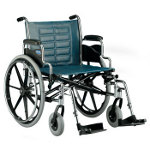The Wheelchair Guide
Your Wheelchair and Mobility Scooter Resource
The Development of the Modern Wheelchair
Monday, January 25th, 2010
 The wheelchair is one of the oldest types of home medical equipment, dating back thousands of years, with images depicting the use of carts and similar devices, used to transport those with limited mobility. However, if you looked at most of the early wheelchairs, you might not even recognize them as a wheelchair, nor where they something that was generally available to the regular population.
The wheelchair is one of the oldest types of home medical equipment, dating back thousands of years, with images depicting the use of carts and similar devices, used to transport those with limited mobility. However, if you looked at most of the early wheelchairs, you might not even recognize them as a wheelchair, nor where they something that was generally available to the regular population.
In the past, wheelchairs were traditionally only available to those such as nobility or who had the means to have one constructed. This is because there was no set standard to them, so instead the wheelchair had to basically be reinvented each time it was built, relying on the skills of the builder.
Towards the end of the nineteenth century, this began to change, with a semi-standard wicker wheelchair becoming much more common. This was in part due to the increased number of war veterans from the Civil War. These early wheelchairs where relatively inexpensive and featured a large wicker chair, which was often very high backed. Sometimes, however, wood was used in place of wicker, which was much sturdier, but also a great deal heavier.
While a big step up from the older models of wheelchairs, the wicker and wood wheelchairs were very cumbersome and could rarely be transported easily. They also usually required someone to push the wheelchairs, leaving the wheelchair user dependent on friends, nurses, or other caregivers to get around. These wheelchairs would remain common until the early 1930′s, when a much lighter wheelchair was developed.
The improved wheelchair, which was developed during the 1930′s was referred to as the E&J wheelchair, named for its inventors Everest and Jennings. What sets this apart from other wheelchairs was that it had a solid metal frame, constructed using hollow steel tubes. This provided a great deal of strength, but because the metal was hollow, it was not very heavy. The E&J wheelchair could also be folded up, making it much easier to transport in carriages and the less common automobile. In addition, the wheelchair featured large front wheels, allowing the wheelchair user to self propel, without the need to rely on a caretaker.
As was the case with the previous wheelchair design, much of the innovation and adoption was the result of injured veterans, this time from World War I. A few years later, World War II would begin and the E&J wheelchair would become the default wheelchair design.
By the 1950′s, the E&J wheelchair was still the most common choice of wheelchair, with inventors creating a electric wheelchair kit that could be used to convert a regular manual wheelchair to an electric one. These kits became very popular, with companies from Canada and New York developing quick converter kits.
Today, the E&J wheelchair design is still seen in most manual wheelchairs, with its lightweight hollow metal frame and folding design, making it a great choice for traveling. In fact, Everest and Jenning wheelchairs are still available, as the company has remained a powerful name in the wheelchair industry.